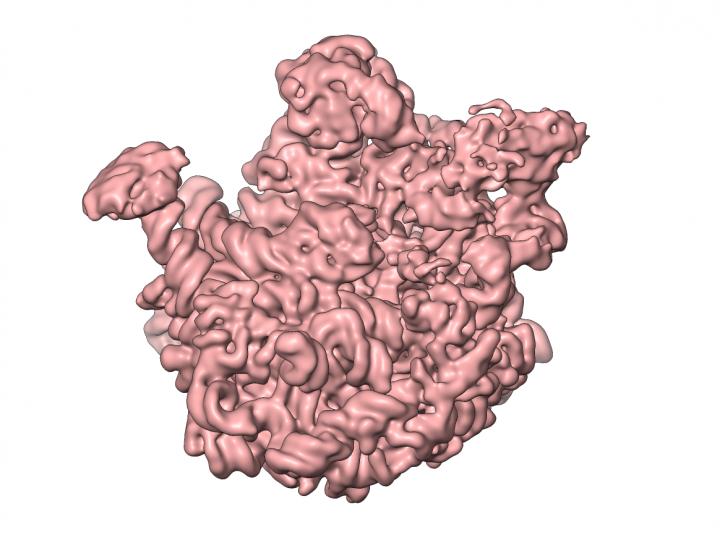Observing the cell's protein factories during self-assembly

Snapshot capturing a moment in the assembly of a bacterial 50S subunit. At this stage in the process, similarities between the precursors and mature 50S subunits are already at above 95 percent. Credit: Charité/Nikolay
Ribosomes are the 'protein factories' of the cell and are composed of two units: a larger 50S subunit, and a smaller 30S subunit. The larger 50S subunit in turn comprises 33 different proteins and 2 ribonucleic acid molecules. The aim of the study was to obtain detailed information about the way in which these numerous different molecules form 50S subunits in bacteria.
In a process known as 'in vitro reconstitution', the individual components were first purified and then mixed together in the laboratory. The researchers then observed how the 50S subunit assembled from this mixture. Using 3D cryo-electron microscopy, a technology whose developers received the 2017 Nobel Prize in Chemistry, they were able to produce high-resolution snapshots of individual stages of the 50S subunit's assembly and maturation. This allowed them to identify, on a molecular level, the individual steps involved in its development.
Explaining the significance of this study, Dr. Rainer Nikolay, of Charité's Institute of Medical Physics and Biophysics, comments: “These results do not simply provide us with important insights into one of the essential processes taking part inside the cell. They also provide us with information on potential targets for new antibacterial drugs.”
These could potentially inhibit ribosome assembly, thereby paralyzing the bacterium's ability to synthesize proteins; these drugs could therefore be used to inhibit all bacterial growth.
Dr. Nikolay plans to conduct additional research to test whether the process of 50S subunit assembly inside the living cell is the same as that observed outside the cell. He explains: “Much of the information available in the literature suggests that 50S assembly in vivo follows a very similar course to that observed in vitro. To test this assumption, we are currently developing methods capable of analyzing the structure of 50S ribosomal subunit precursors, which we will obtain directly from cells.”
###
*Nikolay R, Hilal T, Qin B, Mielke T, Bürger J, Loerke J, Textoris-Taube K, Nierhaus KH, Spahn CMT. Structural visualization of the formation and activation of the 50S ribosomal subunit during in vitro reconstitution. Molecular Cell 2018. DOI: 10.1016/j.molcel.2018.05.003.
Media Contact
All latest news from the category: Health and Medicine
This subject area encompasses research and studies in the field of human medicine.
Among the wide-ranging list of topics covered here are anesthesiology, anatomy, surgery, human genetics, hygiene and environmental medicine, internal medicine, neurology, pharmacology, physiology, urology and dental medicine.
Newest articles

NASA: Mystery of life’s handedness deepens
The mystery of why life uses molecules with specific orientations has deepened with a NASA-funded discovery that RNA — a key molecule thought to have potentially held the instructions for…

What are the effects of historic lithium mining on water quality?
Study reveals low levels of common contaminants but high levels of other elements in waters associated with an abandoned lithium mine. Lithium ore and mining waste from a historic lithium…

Quantum-inspired design boosts efficiency of heat-to-electricity conversion
Rice engineers take unconventional route to improving thermophotovoltaic systems. Researchers at Rice University have found a new way to improve a key element of thermophotovoltaic (TPV) systems, which convert heat…



